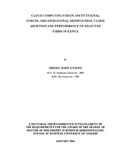| dc.description.abstract | The adoption of IT innovations has been a major area of research in information
systems. The determinants of IT innovations are known to vary on the basis of the
nature of the innovation and the context of adoption. While there is substantial
literature on the adoption of various IT innovations based on utility computing, there
is a dearth of empirical literature on cloud computing adoption by business
organizations. Further, a majority of the empirical studies that have investigated cloud
computing adoption by business organizations have done so in the context of
developed countries. Given that cloud computing adoption has been steadily
increasing in Kenya, the current study aims at investigating the determinants and
antecedents of cloud computing adoption and the effect of cloud computing adoption
on firm performance. To this end, the study adapted the socio-cognitive theories of
organizing vision, institutional forces and organizational mindfulness to understand
cloud computing adoption and its effect on firm performance. To achieve the overall
goal of the study, hypotheses were formulated to test the relationship between cloud
computing vision, institutional forces and organizational mindfulness on cloud
computing adoption; between cloud computing adoption and firm performance; and
the interaction effect of organizational mindfulness on all the relationships. The
relationships and the interaction effects were specified in a SEM diagram comprising
of measurement and structural models. A firm level cross sectional survey was
conducted on selected firms within the financial, ICT and manufacturing sectors in
Kenya. Of the 180 firms sampled, 93 completed the questionnaire resulting in a 51.6
percent response rate. The responses were then used to test the study hypotheses.
Exploratory factor analysis was conducted to purify the data and partial least squares
structural equation modeling used to evaluate the reliability and validity of both the
measurement and structural models. The results indicate that institutional forces and
organizational mindfulness have a significant positive relationship with cloud
computing adoption. Cloud computing adoption was found to have a significant
positive relationship with firm performance. The relationship between cloud
computing vision and cloud computing adoption was found to be negative and
insignificant. The results further showed that the interaction effect of organizational
mindfulness on all the relationships was very low and insignificant. These research
findings show that institutional forces and organizational mindfulness plays a leading
role in determining organizations’ adoption of cloud computing. More importantly,
the results indicate that cloud computing adoption significantly improves firm
performance. A major implication of this study is that community discourse on cloud
computing needs to be enhanced to build a cloud computing vision as its effect on
cloud computing adoption was found to be negative and insignificant. The
government, universities, consultancy firms, professional bodies and industry
associations should participate and facilitate cloud computing discourse. The findings
of this study have theoretical and practical implications on the adoption and
implementation of IT innovations. Additionally, the findings have implications on the
formulation and implementation of IT innovations policy. | en_US |



